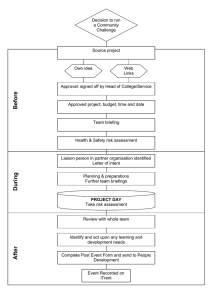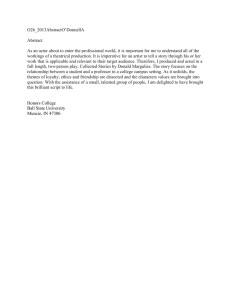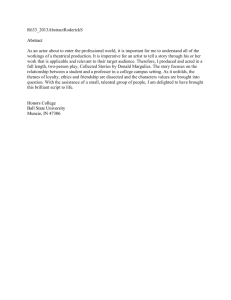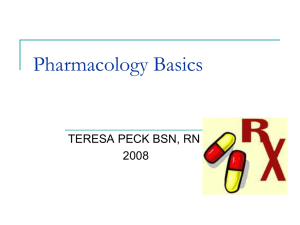Crisis Management Prepared By: Awni Adnan AL-arab Supervised By: Dr. Lo’ai Tawalbeh
advertisement
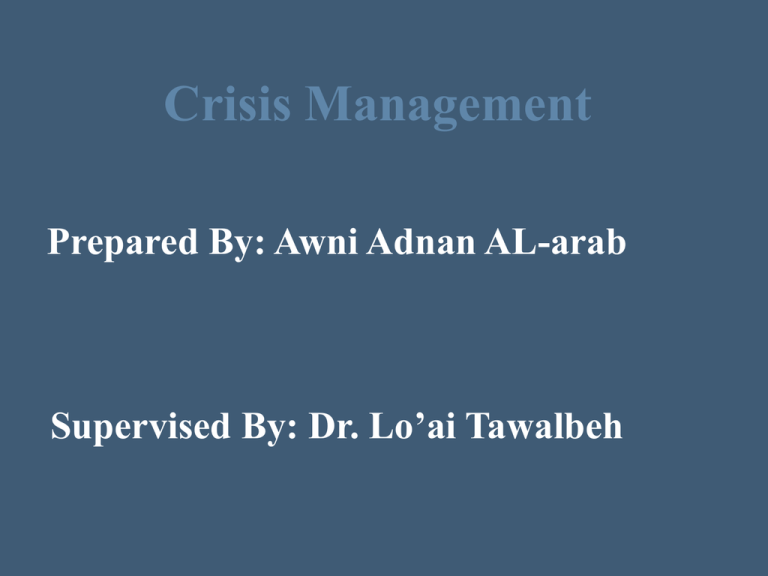
Crisis Management Prepared By: Awni Adnan AL-arab Supervised By: Dr. Lo’ai Tawalbeh Definition • A crisis is defined as an event that by its nature or its consequences: – constitutes a threat to vital national interests or to the essential needs of the population; – prompts rapid decision making; – demands coordination between different departments and organisms Key features of a Crisis • Low probability • High impact • Uncertain/ambiguous causes and effects Common features of a crisis: • • • • • • • • • • • • The situation materialises unexpectedly Decisions are required urgently Time is short Specific threats are identified Urgent demands for information are received There is sense of loss of control Pressures build over time Routine business become increasingly difficult Demands are made to identify someone to blame Outsiders take an unaccustomed interest Reputation suffers Communications are increasingly difficult to manage Crisis Management Crisis Management : prevents a crisis from becoming a catastrophe. Crisis management can be defined as a system or methodology of solving crisis situations. We can be sure that the actual crisis situation will differ from our expectation. A crisis is like a virus, the effects can be sudden , insidious, infectious and extremely dangerous… Problem characterization Crisis management is a very complex and not easily predictable process. The problem can be explicated in three claims: – Nobody knows when a crisis event will happen. – The scenario of a crisis/emergency event can be expected and prepared for but the real situation will change it. – Our knowledge of a crisis/emergency event solution is developed step-by-step and hour-by-hour and its ”current version” has to be utilized continuously in the crisis event solution. Purpose of crisis management: • Prevention • Survival • Successful outcomes Three criteria of success: • Has organisational capacity been restored? • Have losses been minimised? • Have lessons been learned? Crisis Planning: • • • • • • • • • Assess risks Produce plans Define roles and responsibilities Appoint crisis management team Draw up communication plan Produce contact and organisation chart Promote crisis-ready culture Publish plans and conduct training Test, review and practise PRE-CRISIS ACTIONS AND PREPARATIONS • Crisis is no time to find yourself on a learning curve. Community measures and Emergency procedures are essential; • Planning requires that crisis can occur at any time. Nine out of ten crisis occur when you are asleep, probably after a late night or at a week-end! PRE-CRISIS ACTIONS AND PREPARATIONS • Pre-crisis actions costs are often (but not always) a tiny fraction of the losses that are typically incurred by crisis for which there has been inadequate preparation; • It is very easy to underestimate the damage a crisis can do and the costs it can have. PRE-CRISIS ACTIONS AND PREPARATIONS Preparedness at Commission level: • Emergency Procedures • Staff awareness • Network of experts for urgent meeting/advice • Standard Commission Decisions (safeguard clauses) ready in all official languages Pre-crisis actions and preparations 1. The crisis unfolds 2. After the crisis 3. In a Nutshell THE CRISIS UNFOLDS • Appointment of a press contact person who is always available and ready to reply immediately • Quick reaction in taking and repealing measures • Dispatch of information in real time • Consistency of information (everyone should have the same story) • Development of a detailed chronology THE CRISIS UNFOLDS • The services/officials concerned ought to show flexibility and may have to stay late hours, work on week-ends or report their vacations • The work-plans and tasks should be re-organized so as to allow for an effective management of the crisis and all its side effects (letters, working groups…) • Risk assessors and risk managers must work in strict co-operation! THE CRISIS UNFOLDS • Coordination between the Units and Directorates concerned is essential, so as to ensure that all the aspects of the crisis are being tackled . • Show sympathy for those affected by the crisis. AFTER THE CRISIS • Promote positive stories in the media • Analyze the management of the crisis • Update Emergency Procedures IN A NUTSHELL Be prepared • Sooner or later you may also be involved in a crises, which will involve a lot of extra work • What is the most likely scenario for you/your service? Are you ready for it? • The crisis may be worse than you expected! IN A NUTSHELL Say the truth • People and institutions do not like facing and managing crisis. This may lead them into halftruths, lies and evasions • What is said to the media, other bodies needs to be updated and consistent IN A NUTSHELL Be visible • If the crisis is major, then Commissioner needs to be at the site of the crisis quickly and to be visible • Failure to show sympathy will be punished by the media and by all members of the public and can destroy the reputation of the Commission Crisis Communications Communication plan: Core elements are: • Identifying audiences (Who?) • How communication is to take place (How?) • What messages are to be communicated (What?) The core process is: • Active, two-way communication
